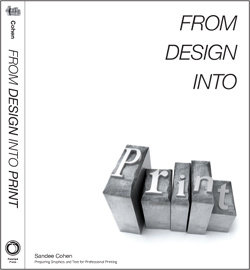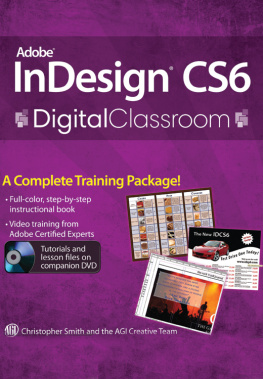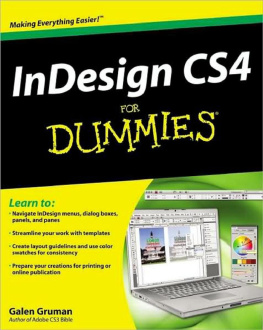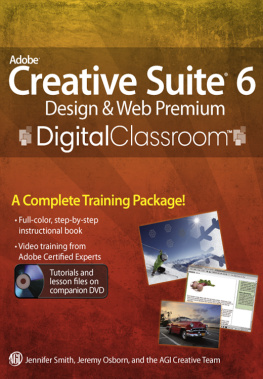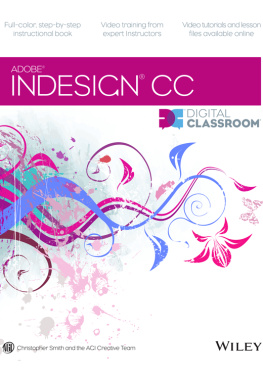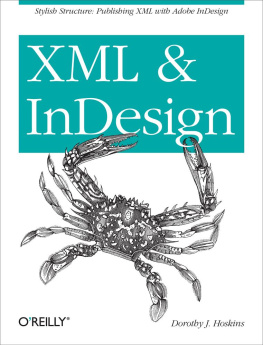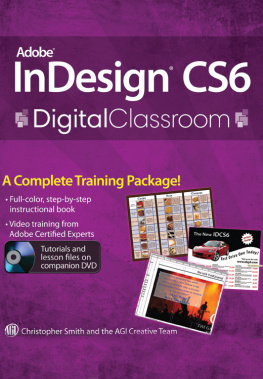Digital Publishing with Adobe InDesign CS6
Sandee Cohen
Diane Burns

Digital Publishing with Adobe InDesign CS 6
Sandee Cohen and Diane Burns
Adobe Press books are published by:
Peachpit
1249 Eighth Street
Berkeley, CA 94710
Peachpit is a division of Pearson Education.
For the latest on Adobe Press books, go to www.adobepress.com.
To report errors, please send a note to
Copyright 2013 by Sandee Cohen and Diane Burns
Adobe Press Editor: Victor Gavenda
Editor: Becky Morgan
Development Editor: Bob Lindstrom
Production Editor: Becky Winter
Copyeditor: Scout Festa
Indexer: Valerie Haynes Perry
Cover design: Mimi Heft
Interior design: Sandee Cohen and Diane Burns
Notice of Rights
All rights reserved. No part of this book may be reproduced or transmitted in any form by any means, electronic, mechanical, photocopying, recording, or otherwise, without the prior written permission of the publisher. For information on getting permission for reprints and excerpts, contact .
Notice of Liability
The information in this book is distributed on an As Is basis, without warranty. While every precaution has been taken in the preparation of the book, neither the authors, Adobe Systems, Inc., nor the publisher shall have any liability to any person or entity with respect to any loss or damage caused or alleged to be caused directly or indirectly by the instructions contained in this book or by the computer software and hardware products described in it.
Trademarks
Adobe, Adobe Digital Publishing Suite, and InDesign are either registered trademarks or trademarks of Adobe Systems Incorporated in the United States and/or other countries.
All other trademarks are the property of their respective owners.
Many of the designations used by manufacturers and sellers to distinguish their products are claimed as trademarks. Where those designations appear in this book, and Peachpit was aware of a trademark claim, the designations appear as requested by the owner of the trademark. All other product names and services identified throughout this book are used in editorial fashion only and for the benefit of such companies with no intention of infringement of the trademark. No such use, or the use of any trade name, is intended to convey endorsement or other affiliation with this book.
ISBN-13: 978-0-321-82373-1
ISBN-10: 0-321-82373-7
9 8 7 6 5 4 3 2 1
Printed and bound in the United States of America
Our Thanks To
Becky Morgan , our Peachpit editor; Bob Lindstrom , the development editor; Scout Festa , our copy editor; Becky Winter , our production editor; Liz Welch , our proofreader, Valerie Haynes Perry , our indexer; Mimi Heft , the cover designer, and Nancy Ruenzel , the publisher of Peachpit Press.
Victor Gavenda of Adobe Press for helping guide the initial development of the book.
Chris Kitchener , Kiyomasa Toma , Annemarie Belliard , and Colin Fleming of Adobe Systems for answering our questions about the intricacies and fast-moving developments of digital publishing from InDesign.
Gabe Harbs of In-Tools for his support in allowing us to use of the Side-Heads plug-in. http://www.in-tools.com/
Steve Werner for his contribution to the ePub and HTML chapter.
Bob Levine for his guidance on working with ePub and HTML.
Anne-Marie Concepcion for her emergency answers to ePub questions.
Robert Shaw of Weldon Owen for use of images.
Denise Lever of TransPacific Digital for design support.
From Sandee
Terry DuPrt for her support during the deadlines. Cini , my Russian Blue cat. And my co-author , Diane Burns , without whom I could not have done this book.
From Diane
Ditto on the co-author thing, Sandee Cohen .
Colophon
This book was created using a 13 MacBook Pro, a 15 MacBook Pro and a 27 iMac. Windows screen shots were taken on a Dell Vostro.
Pages were laid out using Adobe InDesign CS 5.5. Illustrations were created using Adobe Photoshop CS 5 and Adobe Illustrator CS 5. Fonts used were Chaparral Pro and Gill Sans Std.
Screen shots were taken using SnapzPro (Mac) and Snagit (Win).
The automatic positioning of anchored side heads was created using the Side Heads plug-in from in-tools (in-tools.com).
The word cloud illustrations at the front of each chapter were created using the Wordalizer script from indiscripts (indiscripts.com).
Weekly video conferences were held using iChat.
Files were shared using Dropbox Pro.
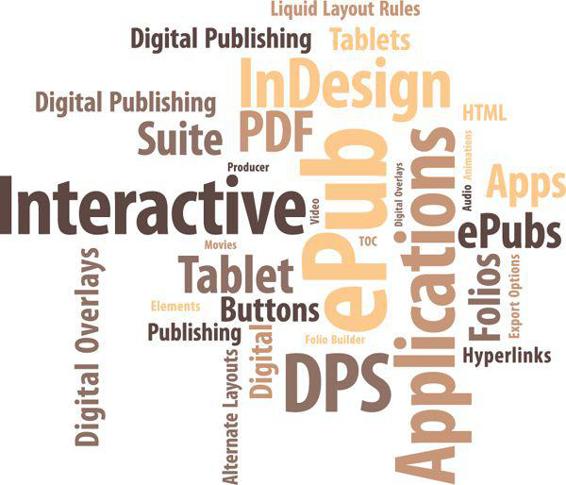
Table of Contents
1. Introduction
In This Chapter
The last time technology was so disruptive to the field of graphic design and publishing was back in the 1980s, when page layout programs were part of a revolution called desktop publishing. Designers and publishers could use programs such as PageMaker or QuarkXPress to set type right at their desks hence the term desktop publishing.
Designers had to learn new skills not just to design pages and art, but to make documents flow correctly and import images with the correct color space and resolution. They had to deal with digital typefaces and missing fonts. (Fonts were always missing!)
But for the longest time, those programs stayed basically the same. Their final output was geared to print publishing. New features were added, but they were always for the printed page.
Slowly, though, the publishing landscape began to change. File formats from Photoshop included the GIF and JPEG images used for web pages. A new page layout program called InDesign leveraged Adobes PDF format to create PDF documents that could be posted and read on the web. Slowly, print designers were exposed to new concepts in computer graphics, mostly related to the web and onscreen PDFs. Designers had to learn a new set of skills for digital and interactive document production.
But all that change was tame compared to what has happened in the past three to four years. The number of print books sold has been surpassed by the number of books downloaded from sites such as Amazon and iTunes. Print magazines have been brought back to life as interactive applications. Corporations are creating presentations for computer screens instead of printed brochures.
Its a whole new world of digital publishing. Exciting times, yes, but the print designer has to rethink and relearn a whole new world.
Who Are We?
We both have backgrounds in traditional publishing, including advertising and design. But individually we have worked with clients to help them create interactive PDF presentations, ePubs, and tablet applications. Weve added movies and interactive elements to educational materials that were originally created for print output, and posted them online. Both of us have taught hundreds of hours of classes on the new digital output formats. Weve written articles and books on how to create interactive PDF documents. And the two of us have seen our own print books sold as ePubs on Amazon and iTunes.
It hasnt been easy
Thats not to say we havent struggled. Both of us had to learn how to format media files so they work on multiple output devices. We had to learn how to read basic HTML and CSS code and learn the proper formats in which to hand over our projects to web designers and Flash ActionScript developers. Both of us had to learn how to apply and modify animation controls. And most of all, we had to learn how to think differently about the presentation of information thats in a digital format, free from the printed page.
Next page

